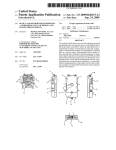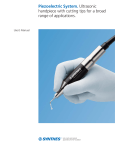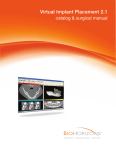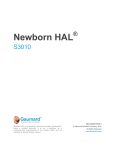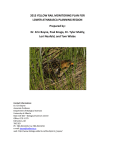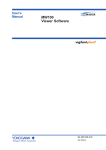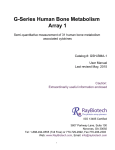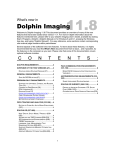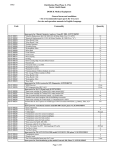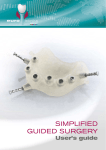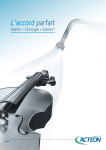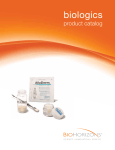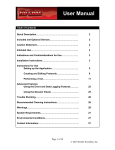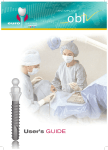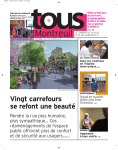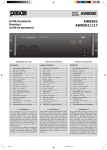Download Clinical booklet - The Ultrasonic dental bone surgery
Transcript
Clinical Booklet Surgery English Power ultrasonics for Safety: Preservation of soft tissue. Speed: A fast, precise and effortless selective cut thanks to ultra-sharp, robust and resistant tips. Comfort: Atraumatic treatments (no bone loss or bleeding), fast healing and greatly reduced post-operative pain. 2 bone surgery by Satelec® More power: up to three times more powerful in Piezotome mode (up to 60W) on PIEZOTOME 2, SOLO (LED), IMPLANT CENTER 2. New light function: the PIEZOTOME 2 and NEWTRON handpieces are equipped with very high power LEDs (100,000 Lux). Finely adjusted power: thanks to the progressiveness of ultrasonics (on PIEZOTOME 2 AND IMPLANT CENTER 2). A wide touch-sensitive screen: easier navigation and programming (on PIEZOTOME 2 AND IMPLANT CENTER 2). 3 Acknowledgements This clinical booklet has been written with the guidance and backing of university lecturers and scientists, specialists and scientic consultants: Dr. G. GAGNOT, private practice in periodontology, Vitré and University Hospital Assistant, Rennes University, France. Dr. S. GIRTHOFER, private practice in implantology, Munich, Germany. Pr. F. LOUISE, specialist in periodontolgy-implantology, Vice Dean of the Faculty of Dentistry, University of the Mediterranean, Marseilles, France. Dr. Y. MACIA, private practitioner, University Hospital Assistant in the Department of Oral Surgery, Marseilles, France. Dr. P. MARIN, private practice in implantology, Bordeaux, France. Dr. J-F MICHEL, private practice in Periodontology and Implantology, Rennes, France. Dr. E. NORMAND, private practice in Periodontology and Implantology, Bordeaux, University Hospital Assistant in Victor Segalen, Bordeaux II, France. Our protocols, and the ndings that support them, originate from university theses and international publications, which you will nd referenced in the bibliography. We have of course gained tremendous experience over the last thirty years from the dentists worldwide who, through their recommendations and advice, have contributed to the improvement of our products. But our special thanks go to each SATELEC user who shows faith in us, each time they choose one of our products. Gilles Pierson President 4 5 Summary Synthesis . . . . . . . . . . . . . . . . . . . . .................................................... 8 Introduction . . . . . . . . . . . . . . . . .................................................. 11 Foreword. . . . . . . . . . . . . . . . . . . . .................................................. 12 I-Technology . . . . . . . . . . . . . . . . .................................................. 13 1.Ultrasonics . . . . . . . . . . . . . . . . ................................................... 14 2.Piezoelectricity . . . . . . . . . . . ................................................... 14 3.The contribution of piezoelectric generators to oral surgery ................... 17 4.Selectivity of ultrasonic cutting effect ........................................ 19 5.Hemostasis . . . . . . . . . . . . . . . . ................................................... 20 6.Histology . . . . . . . . . . . . . . . . . . ................................................... 20 II-Clinical applications . . . . . .................................................. 21 1.Diagnosis of bone loss . . . . . ................................................... 22 2.Bone classication . . . . . . . . . ................................................... 23 3.Healing . . . . . . . . . . . . . . . . . . . ................................................... 23 4.Contraindications. . . . . . . . . . ................................................... 24 III-Clinical procedures. . . . . . .................................................. 25 6 1.Bone Surgery (BS) . . . . . . . . . ................................................... 26 a.Autogenous bone graft . . . ................................................... 26 b.Osteotomy instruments . . ................................................... 28 Instrument sequence . . . . . ................................................... 37 2.Sinus Lift (SL) . . . . . . . . . . . . . ................................................... 38 a.Lateral sinus lift . . . . . . . . . ................................................... 38 b.Instruments for lateral sinus lift approach ................................... 39 Instrument sequence (discarded vestibular bone window) .................... 46 Instrument sequence (preserved vestibular bone window) .................... 47 3.Intralift . . . . . . . . . . . . . . . . . . . ................................................... 48 a.Sinus lift by the crestal approach ........................................... 48 b.Benets of ultrasonics . . . ................................................... 48 c.Instruments for crestal sinus lift............................................. 49 Instrument sequence . . . . . ................................................... 56 4.Crest Splitting . . . . . . . . . . . . . ................................................... 57 a.Crest Splitting technique. ................................................... 57 b.Benets of ultrasonics . . . ................................................... 57 c.Protocol . . . . . . . . . . . . . . . . . ................................................... 58 Instrument sequence . . . . . ................................................... 65 5.Extraction . . . . . . . . . . . . . . . . . ................................................... 66 a.Causes and consequences ................................................... 66 b.Immediate or delayed implant placement ................................... 67 c.Benets of ultrasonics . . . ................................................... 67 d.Syndesmotomy instruments ................................................. 68 Instrument sequence . . . . . ................................................... 75 6.Crown Extension. . . . . . . . . . . ................................................... 77 a.Crown lengthening technique ............................................... 77 b.Biologic width . . . . . . . . . . . ................................................... 77 c.Benets of ultrasonics . . . ................................................... 78 Instrument sequence . . . . . ................................................... 83 IV-Organization of technical environment ................................. 85 1.Packaging of the generators and their accessories ............................. 86 2.Operating zone organization .................................................. 86 3.Cleaning, decontamination and sterilization................................... 88 V-Maintenance . . . . . . . . . . . . . . .................................................. 90 VI-Summary . . . . . . . . . . . . . . . . . .................................................. 94 References . . . . . . . . . . . . . . . . . . .................................................. 98 7 Synthesis MORE SAFETY Selective cutting A selective cut (distinction between hard and soft tissues): only the bone is cut; no risk of injuring soft tissues (nerves, membranes, arteries). Controlled irrigation for great bone healing The two peristaltic pumps (with integrated cassette) offer accurate control and extremely precise irrigation to avoid any heating, resulting in better bone healing and absence of postoperative effects such as edema and pain (10). According to Dr. Harder’s clinical study (5): "The PIEZOTOME produced the smallest increase in intraosseous temperature". MORE PRECISION Very ne A clean, narrow and regular cut to retain maximum bone volume. Particularly robust, SATELEC tips are also adapted to each anatomical context. Visibility of the operative eld The hemostatic effect of cavitation (spray) improves the visibility of the operative eld. Tactile sense The NEWTRON technology that drives the handpiece by "Cruise Control®" guarantees gentle, regular and controlled vibrations of the SATELEC tips, allowing continuous action, even on deep cuts. MORE COMFORT Reliability PIEZOTOME / PIEZOTOME SOLO (LED) / PIEZOTOME 2 / IMPLANT CENTER 2 are reliable, powerful and silent devices. Temperature control No overheating of the handpiece or tips. Efciency of ultrasonics Cuts are made without any effort or pressure. Only a back and forth movement is needed. 8 PRINCIPLES An efcient use of SATELEC ultrasonic tips 1. The active part, in contact with the surface, is generally located on the last 2-3 millimeters of the tips. 2. Paintbrush movement: ultrasonics, piloted by the NEWTRON™ technology require no pressure to be effective. A so-called "paintbrush" movement, where smoothness and dexterity are preferred to obtain the desired atraumatic result. 3. Selective cut: the undeniable advantage of ultrasonic cutting is soft tissue preservation. MAIN CHARACTERISTICS OF ULTRASONIC POWER GENERATORS PIEZOTOME / PIEZOTOME 2 / IMPLANT CENTER 2 • Two ultrasonic functioning modes : PIEZOTOME is intended for pre-implant bone surgery and NEWTRON for conventional tooth treatments. • Automatic recognition of the connected handpiece: NEWTRON or PIEZOTOME. • IMPLANT CENTER 2 has an integrated I-SURGE LED micro-motor. • Two silent peristaltic pumps. • A footswitch to control the device from a distance. PIEZOTOME SOLO (LED) • The best of SATELEC technology in a compact generator. • Dedicated to ultrasonic pre-implant bone surgery. 9 10 Introduction Oral surgery has long been performed with traditional equipment because oral tissue presents good healing potential (apart from certain systemic risk factors) and an absence of vital risk. However, it does have its drawbacks such as difculty to access the operating site, heavy fatigue for the practitioner and post-op trauma for the patient. At the present time, dental surgeons have two types of instrument available to them to perform oral surgery: • Manual instruments; • Motorized instruments: - with rotary movement, - with sonic or ultrasonic vibrations. SATELEC piezoelectric generators (PIEZOTOME / PIEZOTOME SOLO (LED) / PIEZOTOME 2 / IMPLANT CENTER 2) belong to the second category of motorized instruments with ultrasonic vibrations employing a piezoelectric transducer. They were designed with the objective to respond to the drawbacks encountered with traditional instruments and give access to such delicate operations as osteotomies, osteoplasties, ridge expansions, syndesmotomies, and sinus lift. Until the early 90s, certain general practitioners were dissuaded from attempting implantology procedures by the risk of bone loss. Thanks to the latest technological developments, it is possible to offer patients a credible alternative. SATELEC ultrasonic power generators offer comfort, safety and precision to the practitioner during delicate operations. This clinical booklet presents piezoelectric surgery under a technical as well as a surgical angle. It aims to guide the practitioner in the application of this recent technique by means of new protocols. 11 Foreword ! The recommended protocols and instrument sequences described in this booklet are the fruit of our consultants’ experiments, developed during clinical trials in ␣ phase (development) and phase (pre-launching). It is up to each user to adapt or modify them according to the situation. IMPORTANT: Surgical tips designed for the rst generation of PIEZOTOME and IMPLANT CENTER cannot be used with PIEZOTOME 2 / PIEZOTOME SOLO (LED) / IMPLANT CENTER 2 high power generators and vice versa. 12 TECHNOLOGY SATELEC, inventor of the piezoelectric ultrasonic generator for dentistry, is entering a new era by adapting powerful ultrasonics to oral surgery. 1. Ultrasonics Ultrasound waves have a sound frequency greater than 20,000 Hertz (vibrations per second). Humans can hear waves between 20 and 20,000 Hertz. Ultrasound is thus inaudible to humans but perceivable by certain animals such as dogs or dolphins. The use of ultrasound was developed in the 50s and is widely employed today, notably in industry and medical imaging. With the PIEZOTOME handpiece, the ultrasonic wave is transmitted to the tip by a transducer in the handpiece. The piezoelectric ultrasonic vibrations are constituted by waves which: • Move longitudinally; • Move in an environment; • Are reected and absorbed at the interface of various encountered surfaces (17). An ultrasonic device comprises a piezoelectric generator, driven by a footswitch, a handpiece and cord, and a choice of specic instruments according to the clinical protocol. 2. Piezoelectricity At present, the use of piezoelectric instruments in dentistry has become common and their efcacy is demonstrated by different clinical studies. The piezoelectric effect was discovered in 1880, by the physicists Pierre and Jacques Curie, in collaboration with Gabriel Lippmann. According to these two French researchers, the application of compressive forces on certain solid bodies would generate an electric charge. The term "Piezo" is derived from the Greek verb "piezein" which means to compress or squeeze or to press. The solid bodies that possess such a property have crystalline structures such as Quartz, Tourmaline, Seignette Salt or Baryum Titanate. Today, Quartz crystals have been abandoned and piezoelectric handpieces mainly contain ceramics of crystalline structure. 14 Piezo effect can be explained as: • Direct: the properties of certain solid bodies called piezoelectric (for example, Quartz or Ceramic) to electrically polarize (movement of positive and negative charges) under the effect of a mechanical force. • Indirect: all the deformations (expansion or contraction) of certain bodies called piezoelectric under the inuence of polarization, from application of an electric eld. SATELEC piezoelectric handpieces are thus subjected to an indirect effect. Electric current generates a deformation of piezo ceramic rings. The movement of these rings leads to vibrations in the transducer’s axis. The amplier, associated to a tip, increases the vibrational movements emitted by the piezo ceramic rings. The tip thus vibrates along a longitudinal axis as presented in the illustration below. The counterweight deadens the vibrations to the rear and optimizes the electromechanical output. 15 Piloted by SP NEWTRON technology, the most advanced patented electronics in the market, surgical SATELEC devices benet from several instrument control systems: Auto-tuning System Speed Automatic frequency adjustement: 28-36 kHz. + Push-Pull System Gentleness Controlled amplitude of the tip vibrations. + Feed-Back Principle Power Real-time power adjustment. The tip is always tuned into the right vibration frequency. Treatments performed with smooth and painless vibrations. Power (torque) is adjusted intelligently according to the resistance met by the tip. Guaranteed efficiency whatever the environment and/or treatment performed. For preservation of fragile tissues and patient With minimum pressure, more precision and less hand fatigue. = Cruise Control® System Piloted by: Cruise Control® System Automatic system of frequency and power regulation. Stay in complete control and condence. 16 comfort. 3. The contribution of piezoelectric generators to oral surgery Instruments dedicated to pre-implant surgeries are becoming more and more sophisticated. Here is a succinct analysis of various instruments sorted according to their arrival on the market (3-4). Manual instruments remain effective but difcult to maneuver. They hinder the visibility of the practitioner. Moreover, they require a considerable physical effort on the part of the practitioner and their use remains very traumatizing for the patient. Among these instruments, the most commonly employed are scalpels, mallets and surgical osteotomes. They are still widely used in areas with easy access, but are often used in conjunction with motorized instruments. Motorized cutting tools transform their electrical or pneumatic energy into mechanical energy, producing micro-vibrations of the bur or the bone saw. Various styles of cutting have been introduced such as circular and rectilinear movements. Burs activated by a micromotor force the practitioner to go against the torque from the instrument rotation. Saws produce macro-vibrations which also have to be controlled by the practitioner. The cutting feature of a saw does not allow the dental surgeon to control its depth. It is thus preferable to nish this type of intervention by manual instruments in order to avoid too deep an incision which might damage soft tissues, nerves or membranes. The use of these instruments thus remains controversial (see tables below). Bur cutting Advantages Disadvantages Bur can be employed on almost all types of bone. Cutting dependent on the force exercised by the practitioner (resulting in an increase of manual pressure). Speed of action. Temperature rise is more related to the pressure exercised by the practitioner than to the rotation speed (temperature harmful to the bone: 47°C for one minute) (9). Reduced sensitivity and precision of the practitioner due to the vibrations. Dangerous when used close to soft tissues, inferior alveolar nerve and sinus membrane. Strong torque of the instrument makes it dangerous to stop, due to its inertia. 17 Saw cutting Advantages Cutting speed and linearity of the saw-cutting line. Saw can be employed on almost all types of bone. Disadvantages Cutting dependent on the force exercised by the practitioner (resulting in an increase of manual pressure). Reduced sensitivity and precision of the practitioner due to the vibrations. Less control of cutting depth. Dangerous when used close to soft tissues, inferior alveolar nerve and sinus membrane. Saws cannot be employed in zones with difcult access. Piezoelectricity Piezoelectricity in pre-implant and periodontal surgery provides much more comfort and safety to the practitioner. Indeed, it provides precise, ne, effortless cutting without soft tissue injury. Post-operative pain is minor and healing is fast. Furthermore, much less effort is required to obtain a cutting line. Horton J-E et al. (7-8) have demonstrated the advantages of ultrasonic tools, such as the precision provided to the practitioner, the coagulating effect and the absence of post-operative trauma. A comparative study performed at Harvard University by Vercellotti T. (19) compares the extent of bone healing after use of a piezoelectric instrument, a carbide bur and a diamond bur during an osteotomy and osteoplasty on a dog, on the 14th, 28th and 56th day after the procedure. At the 56th day, the sites operated with burs (carbide and diamond) showed bone loss (0.37 and 0.83mm respectively), whereas the sites operated with piezoelectricity presented bone gain of 0.45mm. This study thus proves that the piezoelectric instrument generates bone repair more favorably than burs during osteotomies and osteoplasties. The surgical gesture required for using piezoelectric generators is different from other bone surgery techniques (for example, rotary instruments). Therefore, since it is much more precise and less traumatizing to tissue, this technique demands training and practice to nd the perfect balance between the practitioner’s gesture and the movement speed of the tip. 18 4. Selectivity of ultrasonic cutting effect Due to the selected frequencies ranging between 28 and 36 kHz, in Piezotome mode, the tips are active on hard tissue, limiting the risk of soft tissue injury. The generator produces intermittent ultrasonic vibrations which alternate with weaker amplitude, known as the modulated piezo signal. This modulated signal is said to allow tissue relaxation and optimal cell repair for a clean cut and better healing. Finally, it guarantees an incision free of friction and vibration. Amplitude Piezotome modulation mode Time 1 second In particular, the study of Horton, Tarpley and Jacoway in 1981 (8) demonstrates the cutting precision. The robust tips, associated with limited vibration amplitude, enable very highly precise cutting. Finally, the great maneuverability of the handpiece, combined with the range of tips adapted to each clinical application, allow precise control during all types of treatment. 19 5. Hemostasis Due to its irrigation subject to cavitation, the generators have a hemostatic effect on the cutting surfaces (partially owing to the production of nascent oxygen). The cavitation is characterized by the appearance of micro-bubbles when liquid comes into contact with the tip further to ultrasonic vibrations. When imploding, the cavitation bubbles have a caustic effect. This phenomenon allows achievement of optimal visibility of the operative eld, limits the blood extravasation, cleans the working zones of bone debris and avoids temperature rise susceptible to tissue degradation (16). 6. Histology A histological study was performed in 2001 by T. Vercellotti, A. Crovace, A. Palermo, L. Molfetta (18) in order to observe tissue healing mechanisms after having performed cutting lines with a piezoelectric device. Three orthopedic surgeries were carried out on dogs involving ulnar osteotomy, head and neck osteotomy and laminectomy. This study demonstrated an absence of necrosis signs on the cutting surfaces. Furthermore, the presence of living osteocytes exhibited the weak trauma engendered by this new technique. The macroscopic examinations showed the neatness of cutting. Indeed, devoid of pigmentation or visible signs of necrosis, the cutting surface is perfectly smooth. 20 CLINICAL APPLICATIONS Developed by the Research and Development Department of SATELEC, the ultrasonic power generators (PIEZOTOME / PIEZOTOME SOLO (LED) / PIEZOTOME 2 / IMPLANT CENTER 2) are designed for delicate operations such as osteotomies, osteoplasties, ridge expansions, or sinus lift. 1. Diagnosis of bone loss Above all, a general evaluation of the patient status is essential in order to identify his/her previous medical history, physical and psychological needs. Clinical investigation must be performed to evaluate the extent of bone loss by X-ray (notably panoramic type), tomographies and scanners or three dimensional MRI (Magnetic Resonance Imaging). The practitioner must evaluate bone height and its density by radiography before treatment. According to the study of Harris D. in 1997 (6), bone resorption can have four principal origins: • Pathological (periodontal diseases, cysts, etc.). • Surgical (extraction of embedded canine, apical resection, etc.). • Congenital (micrognathy, oligodontia, clefts, etc.). • Physiological (tooth loss, age, pneumatisation of the maxillary sinus). Bone resorption is a constraint for implant insertion. However, disparities exist because the anterior ridge resorption is four times faster in the mandible compared to the maxilla (3). Bone resorption brings the crestal edge closer to the inferior alveolar nerve in the mandible, and to the sinus cavities in the maxilla. For an implant of 3.75mm in diameter, the quantity of required minimal bone is 4mm transversely and 7mm vertically (15). If the bone height is lower than 6-7mm, a surgical operation of type bone graft or sinus lift will be necessary for insertion of an implant. However, the practitioner will have to encounter different obstacles such as: the inferior alveolar nerve, the maxillary sinus or the nasal fossas according to the location of the future implant. 22 2. Bone classication In implantology, the identication of bone volume is mostly based on the classication of Lekholm and Zarb (1985) who have listed four types of bone density (D): D1 Very high bone density and thick cortical bone. D3 Intermediate bone density, thin cortical bone and dense spongy bone. D2 High bone density and thick cortical bone. D4 Weak bone density, ne or even absent cortical bone and spongy bone. 3. Healing Bone fracture leads inevitably to a trauma which activates a healing response. Within the rst four hours following the operation, the inammatory reaction induces vasodilation, plasma and leukocytes seepage and an appearance of inammatory cells contributing to phagocytosis of cellular and tissue debris (such as macrophages). Simultaneously, at the healing site, angiogenesis or formation of a blood clot (containing blood platelets) and new blood vessels can be observed. This revascularization provides nutrition to cells, necessary for their development and proliferation. It is thus particularly important during patient diagnosis, to make sure of the good quality of vascularization. Finally, the weaker the mechanical trauma, the faster the local circulation will be restored (12). The use of piezoelectric instruments limits the development of trauma. 23 4. Contraindications For a favorable progress of the operation, it is important to verify the general status of the patient. The contraindications are the same as for any surgical operation. However, the use of devices with ultrasound is contraindicated for the bearers of active implants (for both practitioner and patient) such as pacemakers. Furthermore, certain diseases such as cardiopathy (heart disorders), diabetes, bone diseases and patients receiving radiotherapies can be a constraint for an implant placement. Bone structure validation and circulatory evaluation of the patient are essential elements to ensure efcient graft integration and healing. 24 CLINICAL PROCEDURES 1. Bone Surgery (BS) a. Autogenous bone graft Autogenous bone remains the best choice for bone graft operations. Autogenous graft is dened when the graft is derived from the same patient, as donor and recipient. Both surgical acts (harvest and graft placement), have to be done during the same surgical session. The graft can be procured from various parts of the body where dense cortical bone can be found: such as skull (parietal bone), hip (iliac bone) or certain intraoral sites. The PIEZOTOME handpiece and its tips are specically intended for small to average harvests from intraoral sites. Prior to all acts of harvesting or cutting of a bone window, an incision and ap elevation must be performed to have access to the site. It is then essential to preserve a good visibility of the operative eld and a good blood supply, by respecting anatomical structures and avoiding unsightly scars. It is highly recommended to clean the bone out of any trace of soft tissue before the use of tips. Because, as previously explained, the tips cut only hard tissues and will not produce the expected effect in presence of soft tissues. The suture is made by a wound closure without tension. Chin bone harvest The chin bone allows a bone harvest of about 2cm wide and 3cm long. The central part is preserved in order not to modify the shape of the chin. This operation, performed under local anesthesia, has only moderate operative consequences. However, a risk of mobility disturbance of the chin muscles and nerve lesions, notably labial and incisive, can occur following the operation. Advantages Limited bone quantity Accessibility Less abundant spongy bone Rapid healing Frequent loss of sensitivity of anterior teeth Moderate post-operative pain Possible mucosal paresthesia Limited swelling reaction See reference (14). 26 Disadvantages Local anesthesia Ramus bone harvest Ramus bone is useful when small and average extent of bone is needed. Operative consequences are simple and comparable to those of a wisdom tooth extraction. However, it is important to be careful not to hurt nerves, particularly the inferior alveolar nerve. Advantages Disadvantages Highly abundant spongy bone More comfortable general anesthesia Thick cortical bone Difcult access Operative consequences similar to that of the third molar extractions Risk of lesion to the inferior alveolar nerve: scanner necessary No esthetic impairment Specic surgical material See reference (14). To favor a graft integration on the recipient site, the practitioner must rst check the presence of spongy bone, the stability and good integration of the graft. For that purpose, he/she is brought to perform osteoplasties. Required qualities of the recipient site and the graft Recipient site Graft Intact and free of any infectious lesion Cortico-spongy block Existing bone skeleton (scaffold) Stability Presence of spongy bone allowing osteosynthesis No space between the recipient site and the graft Site preparation Graft preparation See reference (14). 27 b. Osteotomy instruments BONE SURGERYTM (BS) tips, principally intended for performing bone graft, allow cutting, excising and remodeling bone structures without any risk of soft tissue lesions. Protocol Having identied the bone decit, the intraoral harvest site (from chin or ramus bone) must be chosen and the ap performed. The recipient site must be exposed before harvesting the graft in order to measure the bone decit and anticipate the graft integration. The BS1 saw marked every 3mm, creates the lines of osteotomy. The angled forms of the BS2L and BS2R saws facilitate horizontal and vertical cuts during ramus bone harvest. The precise and selective cut of saws limits any risk of soft tissue lesions. Ultrasound favors the cleavage of the bone block and thus the graft harvesting. The use of striking instruments and its consequences for the patient is greatly reduced. The recipient site is then prepared, commonly called osteoplasty. The BS4 and BS6 tips allow elimination of granulation tissue, leveling of the site (osteoplasty) and collection of bone shavings to be later integrated into the bone lling material. The bone block is then screwed in and the graft edges rounded off with the BS6 tip or the diamond tips of the SL kit (SL1 or SL2). The bone lling is spread and the site is sutured. Healing varies between 3 to 6 months. The BS5 tip is especially designed for delicate osteotomies (ridge expansion, premarking during a sinus lift). The following tip index charts specify the different clinical applications of each one. 28 29 OSTEOTOMY Saw BS1 available for PIEZOTOME BS1S available for PIEZOTOME 2 / PIEZOTOME SOLO (LED) / IMPLANT CENTER 2 BS1S Ultra-sharp and robust saw, equipped with four specically sharpened teeth, intended for: - in-depth cutting of cortical bone in pre-implant surgery, - surgical orthodontics PiezocisionTM (2), - bone distraction. Depth of cut: 9mm. The laser-marker, placed every 3mm, makes it easier to gauge bone decit and control depth of cut. This extremely sharp bone saw is particularly effective during chin and ramus bone harvesting. PIEZOTOME Irrigationml/min Recommended modes 1 2 3 40-50 4 PIEZOTOME 2 and SOLO (LED) / IMPLANT CENTER 2 Fine settings* Irrigationml/min Recommended modes 30 D1 *Not applicable to PIEZOTOME SOLO (LED). D2 D3 60 D4 1 to 3 OSTEOTOMY Saw Available for PIEZOTOME 2 / PIEZOTOME SOLO (LED) / IMPLANT CENTER 2 BS1 long Ultra-sharp saw, slim prole, equipped with four specically sharpened teeth, intended for facilitating ramus grafts. Depth of cut: 15mm. The laser-marker, placed at 3, 6, 9, 12 and 15mm, makes it easier to gauge bone decit and control depth of cut. This extremely long saw is particularly effective during ramus graft simply by applying the tip all along the graft. Pr. F. Louise PIEZOTOME 2 and SOLO (LED) / IMPLANT CENTER 2 Fine settings* Irrigationml/min Recommended modes D1 D2 D3 31 60 D4 1 to 3 *Not applicable to PIEZOTOME SOLO (LED). OSTEOTOMY Saw BS2L Left-angled bone saw with four teeth, used for cutting the ramus cortical bone. This tip, specially adapted to the anatomical situation, facilitates the cut of ramus cortical bone. Left oriented, it is used to create vertical and horizontal osteotomy lines on the patient’s right mandible. PIEZOTOME Irrigationml/min Recommended modes 1 2 3 40-50 4 PIEZOTOME 2 and SOLO (LED) / IMPLANT CENTER 2 Fine settings* Irrigationml/min Recommended modes 32 D1 *Not applicable to PIEZOTOME SOLO (LED). D2 D3 60 D4 1 to 3 OSTEOTOMY Saw BS2R Right-oriented bone saw with four teeth, used for cutting the ramus cortical bone. This tip, specially adapted to the anatomical situation, facilitates the cut of ramus cortical bone. Right oriented, it is used to create vertical and horizontal osteotomy lines on the patient’s left mandible. Pr. F. Louise PIEZOTOME Irrigationml/min Recommended modes 1 2 3 40-50 4 PIEZOTOME 2 and SOLO (LED) / IMPLANT CENTER 2 Fine settings* Irrigationml/min Recommended modes D1 D2 D3 33 60 D4 1 to 3 *Not applicable to PIEZOTOME SOLO (LED). OSTEOTOMY Scalpel BS4 Circular scalpel angled at 130°, for osteoplasty and harvesting of bone particles or chips. Treatments: Ridge osteoplasty, periodontal surgery, cysts exeresis, etc. During bone graft, this tip shapes the recipient site (osteoplasty) in order to ensure the graft stability, facilitating its integration. Used during sinus lift,it collects bone shavings of the vestibular bone window. The aspirated autogenous bone will be harvested in a bone lter to be integrated later into the bone lling material. In the case of a cyst, the BS4 planes the site until the cystic follicle is perfectly exposed. PIEZOTOME Irrigationml/min Recommended modes 1 2 3 35-40 4 PIEZOTOME 2 and SOLO (LED) / IMPLANT CENTER 2 Fine settings* Irrigationml/min Recommended modes 34 D1 *Not applicable to PIEZOTOME SOLO (LED). D2 D3 60 D4 1 to 3 OSTEOTOMY Scalpel BS5 Flat scalpel, for ne osteotomies. Treatments: ridge expansion, thin osteotomy, distraction, preparation of buccal bone ap on thick cortical terrain prior to sinus lift surgery. Sharpness and precision characteristics of the BS5 are undeniable advantages for performing other numerous surgical acts. For instance, it can be used at the very beginning of the surgery to perform a marking line during bone distraction or sinus lift. Ridge expansion Pre-marking of the bone window PIEZOTOME Irrigationml/min Recommended modes 1 2 3 35-40 4 PIEZOTOME 2 and SOLO (LED) / IMPLANT CENTER 2 Fine settings* Irrigationml/min Recommended modes D1 D2 D3 35 60 D4 1 to 3 *Not applicable to PIEZOTOME SOLO (LED). OSTEOTOMY Scalpel BS6 Curved scalpel particularly recommended for osteoplasty. Treatments: remodeling, curettage and harvesting of bone chips. An osteoplasty tip, the BS6 cleans the recipient site, smooths surface defects and eliminates adhering periostium (brocellular layer) in order to best adapt the recipient site to the graft. It can serve for remodeling the graft to eliminate any secant or aggressive zone and to separate the cortical bone graft from subjacent medullary tissue during grasp of the graft. Finally, it levels the surrounding ridge during ridge expansions. PIEZOTOME Irrigationml/min Recommended modes 1 2 3 35-40 4 PIEZOTOME 2 and SOLO (LED) / IMPLANT CENTER 2 Fine settings* Irrigationml/min Recommended modes 36 D1 *Not applicable to PIEZOTOME SOLO (LED). D2 D3 60 D4 1 to 3 Instrument sequence Ramus bone harvest 1 2 3 4 5 6 7 8 Ramus bone harvest and graft remodeling for lling of bone decit on tooth 11. 37 2. Sinus Lift (SL) a. Lateral sinus lift The sinus cavity naturally tends to increase its volume with time (see illustration below). Furthermore, the extraction of a tooth situated in the maxillary sinus area entails a loss of bone height (called pneumatisation of the sinus) and a loss of alveolar bone. The placement of an implant in a bone decit zone can then lead to a membrane perforation. The sinus membrane acts as an immune barrier responsible for the maintenance of the healthy sinus. It is thus necessary to perform a sinus lift by an elevation of the membrane, then by an integration of biomaterials. For this type of operation, the patient is put under local anesthesia. A ap is then performed and then opened on the antero-lateral wall of the upper maxilla. Different techniques of window cutting can be employed. However, considering the risks of membrane perforation when moving bone window inward into the sinus (Tatum's technique), it is recommended to remove and separate the whole perimeter of bone window fragment. 38 b. Instruments for lateral sinus lift approach The SINUS LIFTTM (SL) kit, consisting of ve ultrasonic tips, is specically designed for sinus lift. The sinus cavity naturally tends to increase in volume with time. Having identied the bone decit, a ap must be performed with scalpel under local anesthesia. The vestibular bone window is operated with the SL1 diamond tip by a horizontal incision, followed by two vertical lines, then a second horizontal incision. The angles of this window are then smoothed with the SL1 and/or the SL2 in order not to damage the sinus membrane. Once the bone block has been prepared, the elevation of the membrane is assured with the SL3 tip. It is introduced between the cortical bone and the membrane (or the bone block, according to the method) and separates them approximately 2.5mm apart from the edge. The SL4 and SL5 tips are then used in apical, mesial and then distal position to elevate the edges deeper. It is important during this operation to keep good contact with the edges of the vestibular bone window. The lling of sinus is then performed. Autogenous bone shavings harvested during the operation can be mixed with biomaterials. The bone lling material is then introduced into the bone window and over the whole site. Before suturing the site, collagen or GORE-TEX® or even VICRYL® membranes can be placed to protect and maintain the lling material. Finally, depending on the case, implants are inserted approximately three months after the operation. The following tip index charts specify the different clinical applications of each one. 39 40 SINUS LIFT Diamond SL1 Diamond-coated tip for vestibular bone window cut and for attenuation of sharp angles. This tip is used to perform bone incisions less aggressive than saws. It is recommended to be used during a vestibular bone window cut and attenuation of the sharp angles to protect the nearby anatomical structures. During its use, the practitioner has to perform a constant (longitudinal) sweeping of the surface to be incised. The SL1 remodels all the secant bone zones susceptible to damage the sinus membrane or the tissues surrounding the graft. The marking phase of the bone window can possibly be performed with the BS5. PIEZOTOME Irrigationml/min Recommended modes 1 2 3 40-50 4 PIEZOTOME 2 and SOLO (LED) / IMPLANT CENTER 2 Fine settings* Irrigationml/min Recommended modes D1 D2 D3 41 60 D4 1 to 3 *Not applicable to PIEZOTOME SOLO (LED). SINUS LIFT Diamond SL2 Diamond-coated ball tip for smoothing the vestibular bone window and precise osteoplasty. Ball diameter: 1.5mm. Laser mark every 2mm. This diamond tip performs very ne bone incisions. It is intended for the vestibular bone window cut (of very thin bone) and precision osteoplasty. The SL2 remodels all the secant bone zones likely to damage the sinus membrane or the tissue surrounding the graft. It cleans and renes alveolar bone after tooth extraction. PIEZOTOME Irrigationml/min Recommended modes 1 2 3 40-50 4 PIEZOTOME 2 and SOLO (LED) / IMPLANT CENTER 2 Fine settings* Irrigationml/min Recommended modes 42 D1 *Not applicable to PIEZOTOME SOLO (LED). D2 D3 60 D4 1 to 3 SINUS LIFT Spatula SL3 Plateau tip, non-cutting, for sinus membrane elevation on the window’s edges. Plateau diameter: 5mm. This non-cutting tip is intented for elevating the sinus membrane by approximately 2.5mm on the window edges. During use, it is essential to keep permanent contact between the membrane and the lining bone. Finally, in the case of a cyst, the SL3 tip separates it from the osseous wall. PIEZOTOME Irrigationml/min Recommended modes 1 2 3 35-40 4 PIEZOTOME 2 and SOLO (LED) / IMPLANT CENTER 2 Fine settings* Irrigationml/min Recommended modes D1 D2 D3 43 50 D4 1 to 3 *Not applicable to PIEZOTOME SOLO (LED). SINUS LIFT Spatula SL4 Non-cutting spatula, oriented at 90°, for sinus membrane elevation inside the sinus. Spatula diameter: 4mm. This tip is intended for sinus membrane elevation and disengagement of anatomical structures. During use, the practitioner should keep it permanently touching the bone edges. The elevation is undertaken at the apical, mesial then distal parts. Finally, in the case of a cyst, the SL4 tip separates it from the osseous wall. PIEZOTOME Irrigationml/min Recommended modes 1 2 3 35-40 4 PIEZOTOME 2 and SOLO (LED) / IMPLANT CENTER 2 Fine settings* Irrigationml/min Recommended modes 44 D1 *Not applicable to PIEZOTOME SOLO (LED). D2 D3 30 D4 1 to 3 SINUS LIFT Spatula SL5 Non-cutting spatula, oriented at +/- 135°, used for sinus membrane elevation inside the sinus and for disengagement of anatomical structures. Spatula diameter: 4mm. This tip is used for sinus membrane elevation and disengagement of anatomical structures. During use, the practitioner should keep it in contact with the bone edges. The elevation is undertaken at the apical, mesial then distal parts. Finally, in the case of a cyst, the SL5 tip separates it from the osseous wall. PIEZOTOME Irrigationml/min Recommended modes 1 2 3 35-40 4 PIEZOTOME 2 and SOLO (LED) / IMPLANT CENTER 2 Fine settings* Irrigationml/min Recommended modes D1 D2 D3 45 30 D4 1 to 3 *Not applicable to PIEZOTOME SOLO (LED). SINUS LIFTInstrument Sequence Discarded vestibular bone window 1 2 3 4 5 6 7 The surgical principle of a sinus lift is as follows: cutting the vestibular bone window, elevating the sinus membrane, lling and suturing the site. 46 Photos were taken during two operations. Diamond Instrument Sequence Preserved vestibular bone window Swinging vestibular bone window towards sinus membrane during a sinus lift. 47 3. Intralift a. Sinus lift by the crestal approach The sinus elevation can be achieved by the lateral or crestal approach. The INTRALIFTTM kit is intended for the latter technique, consisting in using the same path as the implant socket, raising the sinus membrane and placing, if the primary stability permits it, the implant(s) during the same surgery (21). Introduced by Summers in 1994, this technique used manual osteotomes. Minimally invasive, it is now feasible with the INTRALIFT kit associated with SATELEC ultrasonic power devices. Drilling is done with four diamond coated tips of increasing diameter. The TKW5 non diamond-coated tip, with internal irrigation, is designed for sinus membrane elevation. b. Benets of ultrasonics 48 Security The selective cut limits the risk of injury to soft tissues (membranes, arteries...). Efciency Rapid and minimally-invasive technique. Large and homogenous membrane lifting. Visibility The cavitation effect allows optimal visibility of the operative eld and cleans the working sites of bone debris that could puncture the mucosa. Comfort Drill without effort or risk. No need for a mallet. C. Instruments for crestal sinus lift Developed for sinus lift by the crestal approach, the INTRALIFT kit makes it possible to perform non invasive surgery in full safety. 1. Reveal Alveolar Crest Bone by a 8x8mm top crest ap or 6mm diameter crestal punch and use an implant pilot drill if the residual bone is more than 3mm. Stop drilling before sinus oor. 2. Pilot drilling with TKW1 (Ø 1.35mm) in very dense cortical bone when residual bone is less than 3mm. Stop drilling 1mm before reaching the sinus oor bone. 3. Use the cylindrical TKW2 tip (Ø 2.1mm) to drill, widen the access canal and open the sinus oor to have a direct view on the membrane. Check with unilateral Valsalva-test. 4. Perform a receptacle preparation with TKW4 (Ø 2.8mm) of 2mm depth (control with the laser marks which are placed every 2mm). If alveolar crest is only 1-2mm receptacle depth should be 0.5mm. 5. Place a collagen sponge in contact with the sinus membrane for additional perforation protection. 6. Insert the TKW5 tip into the receptacle preparation previously performed, check if TKW5 is press-t sealed into the receptacle and activate the ultrasonics for 5 seconds (this will create an augmentation volume of 2.5ml under the sinus membrane). Check oating of sinus-membrane by direct view or by unilateral Valsalva-test. 7. Use the TKW3 (Ø 2.35mm) to widen the access canal to the sinus membrane prior to plugging bone graft. Because of the selective cut of the ultrasonics and as the membrane has already been fully detached the risk of membrane perforation is almost zero if applied carefully. 8. Widen even more the canal with the TKW4 (Ø 2.8mm). 9. Insert the bone grafting material. 10. Perform the "Plug & Spray" technique with TKW5 for 2-3 seconds if bone graft gets stuck in the canal and/or to disperse the bone graft evenly on the sinus oor. 11. Complete the biomaterial insertion. 12. Place the implant if you have enough primary stability. Take into consideration that the implant will consume 50% of the augmentation volume so insert only 50% of bone graft in order to prevent a membrane rupture during implant insertion 49 50 SINUS LIFT Drill (crestal approach) TKW1 Conical tip intended for bone drilling. Diameter: 1.35mm. Conical (Ø 1.35mm) and diamond-coated tip for pilot drilling. Drill the upper maxilla from the crest to the sinus oor. PIEZOTOME Irrigationml/min Recommended modes 1 2 3 80 4 PIEZOTOME 2 and SOLO (LED) / IMPLANT CENTER 2 Fine settings* Irrigationml/min Recommended modes D1 D2 D3 51 100 D4 3 *Not applicable to PIEZOTOME SOLO (LED). SINUS LIFT Drill (crestal approach) TKW2 Cylindrical tip intended for bone drilling. Diameter: 2.1mm. Cylindrical (Ø 2.1mm) and diamond-coated tip for drilling and fracturing the sinus oor. PIEZOTOME Irrigationml/min Recommended modes 1 2 3 80 4 PIEZOTOME 2 and SOLO (LED) / IMPLANT CENTER 2 Fine settings* Irrigationml/min Recommended modes 52 D1 *Not applicable to PIEZOTOME SOLO (LED). D2 D3 100 D4 3 SINUS LIFT Drill (crestal approach) TKW3 Cylindrical tip intended for bone drilling. Diameter: 2.35mm. Cylindrical (Ø 2.35mm) and diamond-coated tip dedicated to drill and widen the access canal to the sinus membrane. PIEZOTOME Irrigationml/min Recommended modes 1 2 3 80 4 PIEZOTOME 2 and SOLO (LED) / IMPLANT CENTER 2 Fine settings* Irrigationml/min Recommended modes D1 D2 D3 53 100 D4 3 *Not applicable to PIEZOTOME SOLO (LED). SINUS LIFT Drill (crestal approach) TKW4 Flat end tip intended for bone drilling. Diameter: 2.80mm. Cylindrical (Ø 2.80mm) and diamond-coated tip intented for the receptacle preparation and widening the access canal to the sinus membrane. PIEZOTOME Irrigationml/min Recommended modes 1 2 3 80 4 PIEZOTOME 2 and SOLO (LED) / IMPLANT CENTER 2 Fine settings* Irrigationml/min Recommended modes 54 D1 *Not applicable to PIEZOTOME SOLO (LED). D2 D3 100 D4 3 SINUS LIFT Spatula (crestal approach) TKW5 Non-cutting tip for sinus membrane elevation by the crestal approach. Non cutting tip, that delivers sterile irrigation spray through the end of the tip, used for sinus membrane elevation by means of microcavitation. Tip to be placed in the receptacle preparation for sinus membrane elevation by crestal approach. The membrane elevation is achieved gradually by a successive increase of irrigation ow rate. The TKW5 can also be used for compacting bone lling materials. Never place the vibrating TKW5 tip in direct contact with the membrane. Detachment Compaction** PIEZOTOME Irrigationml/min Recommended modes 1 2 3 30-40 4 PIEZOTOME 2 and SOLO (LED) / IMPLANT CENTER 2 Fine settings* Irrigationml/min Recommended modes D1 D2 D3 ** Compaction < 3 seconds: PIEZOTOME: mode 2, 10ml/min PIEZOTOME 2 and SOLO (LED)/IMPLANT CENTER 2: D3 (1 to 3), 10ml/min 55 30-40 D4 1 *Not applicable to PIEZOTOME SOLO (LED). Instrument sequence 1 2 3 4 5 6 7 8 Photos were taken during two operations. 56 4. Crest Splitting (CS) a. Crest splitting technique The ridge expansion technique, introduced for the rst time by Bruschi and Scipioni in 1990 (13), allows an implant placement in the ridges originally having decient thickness. With use of CS tips, the vestibular and lingual (or palatal) cortical bones are separated, then the implant can be introduced between both cortical bones. The CS tips can smoothly enlarge the crest, one by one, avoiding the risks of bone breaking. b. Benets of ultrasonics Minimally invasive Thanks to the ultrasonic selective cut, a minimal ap can be performed. Precision Tips thinness provide less bone loss. Security A progressive and smooth crest enlargement to avoid any bone fracture. 57 c. Protocol 1. Perform with a traditional scalpel a single top alveolar crest incision and then use the CS1 ultrasonic tip for a vertical longitudinal pilot osteotomy with 8mm depth. A laser mark every 2mm gives control over the osteotomy until the minimum depth of 7-8mm is reached. 2. Continue your initial lateral expansion with the CS2 again to a minimum depth of 8mm. 3. With the CS3, perform the buccal relief osteotomies (discharge osteotomies at mesial and distal end of the longitudinal osteotomy), to a minimum depth of 8mm equal to the depth of the longitudinal osteotomy. 4. Start your bone expansion with the CS4 tip. Tip thickness: 1.80mm at 8mm. 5. Continue the enlargement with the CS5 tip. Tip thickness: 2.75mm at 8mm. 6. Finalize the expansion with the CS6 tip. Tip thickness: 3.75mm at 8mm. 7. For a one step surgery: insert the implant(s) and ll gaps with bone graft material and close mucosa with adaptive sutures. For a two step surgery: ll the expanded osteotomy with bone graft material and perform adaptive sutures. Insert the implant(s) after a healing period of 3 to 5 months. 58 CREST SPLITTING Scalpel Available for PIEZOTOME 2 / PIEZOTOME SOLO (LED) / IMPLANT CENTER 2 CS1 Fine tip dedicated to pilot osteotomy up to 8mm of depth. Thickness: 0.55mm. Pr. F. Louise PIEZOTOME 2 and SOLO (LED) / IMPLANT CENTER 2 Fine settings* Irrigationml/min Recommended modes D1 D2 D3 Mandible Maxillary 59 80-100 D4 1 to 3 *Not applicable to PIEZOTOME SOLO (LED). CREST SPLITTING Scalpel Available for PIEZOTOME 2 / PIEZOTOME SOLO (LED) / IMPLANT CENTER 2 CS2 Tip dedicated to the second osteotomy up to 8mm of depth. Thickness: 0.85mm. TKW Research Group PIEZOTOME 2 and SOLO (LED) / IMPLANT CENTER 2 Fine settings* Irrigationml/min Recommended modes 60 D1 *Not applicable to PIEZOTOME SOLO (LED). D2 D3 Mandible Maxillary 80-100 D4 1 to 3 CREST SPLITTING Scalpel Available for PIEZOTOME 2 / PIEZOTOME SOLO (LED) / IMPLANT CENTER 2 CS3 Scalpel used for the discharges incisions in mesial and distal sides, always up to 8mm of depth. Thickness: 0.5mm. TKW Research Group PIEZOTOME 2 and SOLO (LED) / IMPLANT CENTER 2 Fine settings* Irrigationml/min Recommended modes D1 D2 D3 Mandible Maxillary 61 80-100 D4 1 to 3 *Not applicable to PIEZOTOME SOLO (LED). CREST SPLITTING Expander Available for PIEZOTOME 2 / PIEZOTOME SOLO (LED) / IMPLANT CENTER 2 CS4 Conical tip for bone expansion. Tip thickness: 1.80mm at 8mm. Pr. F. Louise PIEZOTOME 2 and SOLO (LED) / IMPLANT CENTER 2 Fine settings* Irrigationml/min Recommended modes 62 D1 *Not applicable to PIEZOTOME SOLO (LED). D2 D3 Mandible Maxillary 80-100 D4 1 to 3 CREST SPLITTING Expander Available for PIEZOTOME 2 / PIEZOTOME SOLO (LED) / IMPLANT CENTER 2 CS5 Conical tip for bone expansion. Tip thickness: 2.75mm at 8mm. Pr. F. Louise PIEZOTOME 2 and SOLO (LED) / IMPLANT CENTER 2 Fine settings* Irrigationml/min Recommended modes D1 D2 D3 Mandible Maxillary 63 80-100 D4 1 to 3 *Not applicable to PIEZOTOME SOLO (LED). CREST SPLITTING Expander Available for PIEZOTOME 2 / PIEZOTOME SOLO (LED) / IMPLANT CENTER 2 CS6 Conical tip for bone expansion. Tip thickness: 3.75mm at 8mm. Pr. F. Louise PIEZOTOME 2 and SOLO (LED) / IMPLANT CENTER 2 Fine settings* Irrigationml/min Recommended modes 64 D1 *Not applicable to PIEZOTOME SOLO (LED). D2 D3 Mandible Maxillary 80-100 D4 1 to 3 Instrument sequence 1 2 3 4 5 6 7 8 Photos taken by TKW Research Group 65 5. Extraction a. Causes and consequences Anatomical crowding and/or bad occlusion Wisdom teeth (impacted or not) and/or ankylosed teeth Periodontal disease Insufcient bone and/or gingival support Bacterial involvement Advanced caries on exposed roots or furcations Shock/Trauma Crown or root fracture/crack Infection Abscess (eg. situated at the root apex) Orthodontic, prostheticor maxillo-facial treatment (eg. shortening of the dental arch) 66 The extraction of a tooth leads to an inevitable loss of hard tissue (in height and thickness) and soft tissues. Any delay in treatment presents a risk of engendering such bone loss that an implant placement can only be performed after pre-implant surgery to restore the necessary bone volume. Two approaches are currently used: conventional or delayed post-extraction implant placement and immediate post-extraction implant placement. b. Immediate or delayed implant placement An extraction causes anatomical disorganization. Conventional delayed post-extraction implant placement favors osseointegration. The implant is then placed approximately two months after the extraction and the prosthetic phase will be performed three to six months after the implant placement. Advantages Reliable technique advised in areas where esthetics are a priority. Disadvantages Multiplication of surgical interventions: 1 - Extraction 2-3 - Implant placement and/or prosthetic phase Risk of post extraction bone loss. Immediate post-extraction implant placement considerably reduces the time and the cost of treatment. Advantages Disadvantages Treatment time and cost reduction. Non global technique. Fewer interventions. Minimum primary stability necessary = 5mm. Limited bone resorption. Post implant bone resorption must be evaluated beforehand. Less drilling stages. Only possible for type I and II(1) bone density. After the immediate placement of 1925 implants between 1988 and 2004, Wagenberg (20) obtains an overall success rate of 96%. This technique of extraction and immediate implant placement can thus be recognized as reliable. c. Benets of ultrasonics The use of ultrasonic instruments is much less traumatizing for the patients and preserves the bone tissue essential for osseointegration. Inserted between the cementum and the periodontal ligament of the tooth, the tips will widen the ligamental space. Thus separated from its attachment system, the tooth can be removed rapidly and with a less traumatic luxation. The alveolar bone edge can be kept intact since the tip essentially acts on the tooth and not on the bone. An alveolectomy is therefore avoided. Less aggressive than cutting burs mounted on rotary instruments, the risk of involuntarily damaging the bone septum, which could harm the gingival papilla, is avoided. Without inertia, these extraction tips limit the risk of lesions to adjacent teeth and roots. (1) Classication of Lekholm and Zarb 67 The ultrasonic tips, active on hard tissue and non-active on soft tissues, offer the practitioner greater safety in the presence of such anatomical elements as the inferior mandibular nerve, lingual nerve, antral artery, sinus membranes, etc. Indeed, the frequency modulation renders the tips harmless to surrounding soft tissues (mucosa). d. Syndesmotomy instruments Usage guidelines according to Dr. Gagnot’s recommendations (11): • The tip must be activated before its insertion in the periodontal space. • The tip must be placed parallel to the root. • Perform a to-and-fro movement towards the apex. • It is important not to exert a lever effect with the tips. 60-80 PIEZOTOME Recommended modes Irrigationml/min PIEZOTOME 2 and SOLO (LED) / IMPLANT CENTER 2 Recommended modes Irrigationml/min PIEZOTOME 2 and SOLO (LED) / IMPLANT CENTER 2 Schematic representation courtesy of Dr. Gagnot G. Recommended modes 68 Fine settings* Irrigationml/min SYNDESMOTOMY Scalpel LC1 Ultrasonic periotome intended for syndesmotomy and periradicular osteotomy. Length of active part: 9mm. This tip can be inserted deeply and with great care, along the periodontal ligament, between the root and the alveolar bone. PIEZOTOME Irrigationml/min Recommended modes 1 2 3 60-80 4 PIEZOTOME 2 and SOLO (LED) / IMPLANT CENTER 2 Fine settings* Irrigationml/min Recommended modes D1 D2 D3 69 60-80 D4 1 to 3 *Not applicable to PIEZOTOME SOLO (LED). SYNDESMOTOMY Scalpel LC1 90° Oriented at 90°, the active part of the tip can easily reach the difcult to access areas. Length of active part: 9mm. This ultrasonic periotome facilitates widening of the periodontal space in the interproximal, lingual and distal areas of molars. Pr. F. Louise PIEZOTOME Irrigationml/min Recommended modes 1 2 3 60-80 4 PIEZOTOME 2 and SOLO (LED) / IMPLANT CENTER 2 Fine settings* Irrigationml/min Recommended modes 70 D1 *Not applicable to PIEZOTOME SOLO (LED). D2 D3 60-80 D4 1 to 3 SYNDESMOTOMY Scalpel LC2 The particularly slim LC2 allows access to the tight spaces between the root and the alveolar bone without risk of damaging cortical bone. Length of active part: 10mm. Pr. F. Louise PIEZOTOME Irrigationml/min Recommended modes 1 2 3 60-80 4 PIEZOTOME 2 and SOLO (LED) / IMPLANT CENTER 2 Fine settings* Irrigationml/min Recommended modes D1 D2 D3 71 60-80 D4 1 to 3 *Not applicable to PIEZOTOME SOLO (LED). SYNDESMOTOMY Scalpel LC2L Oriented at 45° to the left, the LC2L facilitates access to the posterior areas. The tip’s slimness respects the morphology of cortical bone and offers working comfort in the sectors with reduced visibility. Length of active part: 10mm. PIEZOTOME Irrigationml/min Recommended modes 1 2 3 60-80 4 PIEZOTOME 2 and SOLO (LED) / IMPLANT CENTER 2 Fine settings* Irrigationml/min Recommended modes 72 D1 *Not applicable to PIEZOTOME SOLO (LED). D2 D3 60-80 D4 1 to 3 SYNDESMOTOMY Scalpel LC2R Oriented at 45° to the right, the LC2R facilitates access to the posterior areas. The tip’s slimness respects the morphology of cortical plate and offers working comfort in the sectors with reduced visibility. Length of active part: 10mm. PIEZOTOME Irrigationml/min Recommended modes 1 2 3 60-80 4 PIEZOTOME 2 and SOLO (LED) / IMPLANT CENTER 2 Fine settings* Irrigationml/min Recommended modes D1 D2 D3 73 60-80 D4 1 to 3 *Not applicable to PIEZOTOME SOLO (LED). SYNDESMOTOMY Saw Ninja™ This saw-tooth tip with double cutting surfaces is endowed with a laser marker every 3mm, to evaluate depth or cutting thickness. It is particularly effecient for hemisections and root amputations. It is also indicated to split impacted molars during extraction. Length of active part: 9mm. Dr. E. Normand Pr. F. Louise PIEZOTOME Irrigationml/min Recommended modes 1 2 3 60-80 4 PIEZOTOME 2 and SOLO (LED) / IMPLANT CENTER 2 Fine settings* Irrigationml/min Recommended modes 74 D1 *Not applicable to PIEZOTOME SOLO (LED). D2 D3 60-80 D4 1 to 3 Instrument sequence 75 Instrument sequence 1 2 3 Using the LC1 around the root to facilitate the root avulsion. 76 6. Crown Extension (CE) a. Crown lengthening technique The aim of crown lengthening techniques (surgical or orthodontic) is to increase the clinical crown height of a tooth planned for a conservative or prosthetic restoration. The indications for crown lengthening are many: • Esthetics - Gingival hyperplasia - Poor gingival contour • Bacterial destruction - Sub-gingival caries • Accident - Crown or root fractures or cracks • Pathology - occlusion - Bruxism - Poor occlusion • Iatrogenic factors - Prosthesis which does not respect the biologic width of the cervical margin, perforation, etc. b. Biologic width The biologic width as dened by Gargiulo and al. (1961) is measured from the bottom of the gingival sulcus to the alveolar crest. This length is approximately 2.04mm. The mean depth of the gingival sulcus is 0.69mm. The sum of these two gures, rounded off to 3mm, constitutes the space occupied between the summit of the gingival margin and the alveolar crest, the pre-prosthetic surgical space to be preserved. Respect of the biologic width is essential during treatment and restorative or prosthetic procedures. Not respecting it can engender periodontal lesions such as gingivitis, gingival recession and bone resorption. In order to increase the clinical crown height and restore a healthy physiology, the alveolar crest must be apically positioned at 3mm with regard to the apical nish line of the preparation. The biologic width can therefore physiologically be organized while the access to the cervical nish line of the preparation is improved. The alveolar crest level will determine the nal position of the marginal gingiva. 77 c. Benets of ultrasonics Precision Cutting selectivity Regular and controlled movement. Tips slimness guarantees the bone integrity of the adjacent teeth. Inactive on gingiva. Limits the lesion of periodontal ligament and bers. Visibility Reaches difcult areas of access. Rapid restitution of the necessary biologic width (CE3). Comfort Cavitation phenomenon provides an optimal visibility. Specially developed for this type of procedure, the BS6 tip and three diamond-coated CROWN EXTENSION tips are designed for ostectomy (bone removal) and osteoplasty (bone reshaping). The length of the diamond-coated active part of the CE3 dedicated to ostectomy is calibrated at 5mm thus allowing a rapid re-establishment of the necessary biologic width (laser mark at 3mm). A few millimeters of the root will be exposed by removal of bone to lengthen the clinical crown. 78 CROWN EXTENSION Scalpel BS6 Curved scalpel particularly effective for substancial osseous reshaping. This tip is used to perform osteoplasties and reshaping of the bone not assuring the tooth support. It can also be used to mark a prosthetic reference point on enamel, if needed, where osteoplasty will begin. PIEZOTOME Irrigationml/min Recommended modes 1 2 3 35-40 4 PIEZOTOME 2 and SOLO (LED) / IMPLANT CENTER 2 Fine settings* Irrigationml/min Recommended modes D1 D2 D3 79 60 D4 1 to 3 *Not applicable to PIEZOTOME SOLO (LED). CROWN EXTENSION Diamond CE1 Diamond-coated spherical tip designed for osteoplasty of bone margins. Ball diameter: 1.75mm (with diamond coating). Diamond-coated spherical tip designed particularly for osteoplasty in oral and palatal zones, the CE1 is used on bone tissue not assuring the tooth support. It will be particularly suitable for osseous reshaping over large areas as well as reducing exostosis or osseous irregularities. PIEZOTOME Irrigationml/min Recommended modes 1 2 3 60-80 4 PIEZOTOME 2 and SOLO (LED) / IMPLANT CENTER 2 Fine settings* Irrigationml/min Recommended modes 80 D1 *Not applicable to PIEZOTOME SOLO (LED). D2 D3 60-80 D4 1 to 3 CROWN EXTENSION Diamond CE2 Diamond-coated spherical tip designed for osteoplasty of bone margins. Ball diameter: 1.20mm (with diamond coating). This diamond-coated tip is particularly designed for osteoplasty in interproximal zones. Its extremely small diameter facilitates very precise osseous reshaping. The CE2 is used notably to recreate a good interproximal morphology, thin out bone margins, etc. PIEZOTOME Irrigationml/min Recommended modes 1 2 3 60-80 4 PIEZOTOME 2 and SOLO (LED) / IMPLANT CENTER 2 Fine settings* Irrigationml/min Recommended modes D1 D2 D3 81 60-80 D4 1 to 3 *Not applicable to PIEZOTOME SOLO (LED). CROWN EXTENSION Diamond CE3 Diamond-coated cylindrical tip designed for delicate osteotomies. Extent of the diamond-coated active part: 5mm. Diameter of the active zone: 1.20mm. For a fast restoration of the biologic width (laser mark placed at 3mm). Used perpendicularly or parallel to the bone, this tip is designed for ostectomies of the tooth-supporting bone in interproximal and oral (vestibular) and palatal periradicular zones. PIEZOTOME Irrigationml/min Recommended modes 1 2 3 60-80 4 PIEZOTOME 2 and SOLO (LED) / IMPLANT CENTER 2 Fine settings* Irrigationml/min Recommended modes 82 D1 *Not applicable to PIEZOTOME SOLO (LED). D2 D3 60-80 D4 1 to 3 Instrument sequence 1 2 3 4 5 6 7 8 Crown lengthening with full-thickness ap following the fracture of a lateral incisor (n°12). 83 Instrument sequence 1 2 3 4 5 6 Crown lengthening pre-prothesis with esthetic goal. 84 ORGANIZATION OF TECHNICAL ENVIRONMENT 85 1. Packaging of the generators and their accessories Delivered non-sterile, various packages (BS*, SL**, INTRALIFT, CS***, EXTRACTION, CE****) consist of a sterilization box, a handpiece connected to its cord, a dynamometric wrench and a tips support. Before performing an operation, it is necessary to perform a cycle of sterilization. 2. Operating zone organization Generators can be placed on a mobile NEWTRON or IMPLANT CENTER cart. The shelves allow a combination of a piezoelectric generator (PIEZOTOME / PIEZOTOME SOLO LED / PIEZOTOME 2 / IMPLANT CENTER 2) and a high frequency electrosurge (SERVOTOME®). The irrigation line is connected to the handpiece, clipped with the cord, the cassette placed in the pump and nally the perforator is inserted into a bottle or a pouch of sterile solution. Tips supports Prior to the operation, it is advised to place a bridge table above the patient. The stainless steel support and its tips maintained by silicone rings facilitating their grip can be easily decontaminated, sterilized and placed on this bridge table. * BONE SURGERY, osteotomy ** SINUS LIFT *** CREST SPLITTING **** CROWN EXTENSION 86 Handpiece support It is also recommended to install the handpiece support on the bridge table. The handpiece mounted with its tip can be presented with the head at the top of the support (1). At the end of the operation, the PIEZOTOME handpiece can be introduced upside-down on its support, over a kidney dish (2). (1) (2) Dynamometric wrench The dynamometric wrench allows tip changes as necessary. Having screwed the tip on the handpiece transducer, the practitioner can interlock the wrench and tighten at 90° past abutment. The longer tips that do not t in the dynamometric wrench can be changed by using the universal at wrench (see illustration below). 87 3. Cleaning, Decontamination and Sterilization After surgery, it is important to follow the procedure of decontamination and re-packaging of the device as well as their accessories. The irrigation line must be purged in distilled water after each operation to eliminate remaining physiological serum. Accessories such as tips support, tips and wrench must be disinfected, decontaminated and sterilized. The sterilization box can follow a process of physical (brushing) and chemical (detergent) cleaning. Furthermore, cassettes and trays can be placed in a mechanical cleaning device. PIEZOTOME 2 handpiece: The handpiece’s extremity can be completely unscrewed, facilitating access to and cleaning of the amplier. The light guide and the LED ring of the PIEZOTOME 2 handpiece are accessible for optimum cleaning. It is imperative to remove each item (handpiece, nosecone, light guide, and LED light ring) before cleaning, decontamination and sterilization. 88 Protocol: Manual method Rinse / brush each element in a current cold water, remove dirt. Immerse the items in a cleaning solution or alkaline enzyme. Automatic method Rinse / brush each element in a stream of cold water, remove dirt. Rinse under cold running water. Hand wash each piece in a cleaning solution or alkaline enzyme. Clean / decontaminate manually each element in a cleaning solution or alkaline enzyme. Rinse under cold running water. Rinse thoroughly with distilled water. Pass only the nose of the handpiece in an ultrasonic tank. Hand washing in a solution at pH neutral. Rinse nose under cold running water. Rinse with deionized or puried water. Put each item in a washer / disinfector. Dry. Packaged and sterilized in an autoclave according to current standards. Packaged and sterilized in an autoclave according to current standards. 89 Maintenance 1. Instruments and accessories Tips Surgical tips designed for the rst generation of PIEZOTOME and IMPLANT CENTER cannot be used with PIEZOTOME SOLO (LED) / PIEZOTOME 2 / IMPLANT CENTER 2, high power generators, and vice versa. Wear of tips must be regularly checked by the user. A tip with dulled active part must be changed. Diamond tips must be replaced when the active diamond part becomes smooth and shiny. In anticipation of tip wear, it is recommended to sterilize a second tip kit in advance. Furthermore, to prolong their efciency and precision, it is important to avoid dropping them. For further details, please refer to the relevant kit user’s manual. PIEZOTOME handpiece Before each operation, it is recommended to check the integrity of the handpiece cord. Unscrewing the handpiece extremity allows access to the sealed joint as well as to the screw thread (zone of tip screwing) and thus allows checking for their wear status. The sealed joint ordered through your local retailer can be easily changed. For further details, please refer to the relevant user’s manual. 2. Generator After each operation, it is necessary to check the integrity of power cords, the footswitch and handpieces. The whole generator can be cleaned with disinfectant wipes. It is however important to quickly mop up liquids which might penetrate into the device during the decontamination procedure. 90 For further details, please refer to the user’s manual of your device. 91 91 Summary Tips 94 Maximum recommended modes Irrigation ml/min BS1 1 2 3 4 40-50 BS2L 1 2 3 4 40-50 BS2R 1 2 3 4 40-50 BS4 1 2 3 4 35-40 BS5 1 2 3 4 35-40 BS6 1 2 3 4 35-40 SL1 1 2 3 4 40-50 SL2 1 2 3 4 40-50 SL3 1 2 3 4 35-40 SL4 1 2 3 4 35-40 SL5 1 2 3 4 35-40 Summary Tips Maximum recommended modes Irrigation ml/min TKW1 1 2 3 4 80 TKW2 1 2 3 4 80 TKW3 1 2 3 4 80 TKW4 1 2 3 4 80 TKW5 1 2 3 4 30-40 LC1 1 2 3 4 60-80 LC1 90° 1 2 3 4 60-80 LC2 1 2 3 4 60-80 LC2L 1 2 3 4 60-80 LC2R 1 2 3 4 60-80 NINJATM 1 2 3 4 60-80 CE1 1 2 3 4 60-80 CE2 1 2 3 4 60-80 CE3 1 2 3 4 60-80 95 Summary Tips BS1S Maximum recommended modes D1 D2 D3 Fine setting* Irrigation ml/min 60 D4 1 to 3 BS1L D1 D2 D3 60 D4 1 to 3 BS2L D1 D2 D3 60 D4 1 to 3 BS2R D1 D2 D3 60 D4 1 to 3 BS4 D1 D2 D3 60 D4 1 to 3 BS5 D1 D2 D3 60 D4 1 to 3 BS6 D1 D2 D3 60 D4 1 to 3 SL1 D1 D2 D3 60 D4 1 to 3 SL2 D1 D2 D3 60 D4 1 to 3 SL3 D1 D2 D3 50 D4 1 to 3 SL4 D1 D2 D3 30 D4 1 to 3 SL5 D1 D2 D3 30 D4 1 to 3 TKW1 D1 D2 D3 100 D4 3 TKW2 D1 D2 D3 100 D4 3 TKW3 D1 D2 D3 100 D4 3 96 TKW4 D1 D2 D3 100 D4 3 *Not applicable to PIEZOTOME SOLO (LED). Summary Tips Maximum recommended modes TKW5 D1 CS1 D1 CS2 CS3 CS4 CS5 CS6 D2 D3 Fine setting* Irrigation ml/min 30-40 D4 1 D1 D1 D1 D1 D1 LC1 D1 LC190° D1 LC2 D1 LC2L D1 LC2R D1 NINJATM D1 CE1 D1 CE2 D1 CE3 D1 D2 D3 Mandible Maxillary D2 D3 Mandible Maxillary D2 D3 Mandible Maxillary D2 D3 Mandible Maxillary D2 D3 Mandible Maxillary D2 D3 Mandible Maxillary D2 D3 80-100 D4 1 to 3 80-100 D4 1 to 3 80-100 D4 1 to 3 80-100 D4 1 to 3 80-100 D4 1 to 3 80-100 D4 1 to 3 60-80 D4 1 to 3 D2 D3 60-80 D4 1 to 3 D2 D3 60-80 D4 1 to 3 D2 D3 60-80 D4 1 to 3 D2 D3 60-80 D4 1 to 3 D2 D3 60-80 D4 1 to 3 D2 D3 60-80 D4 1 to 3 D2 D3 60-80 D4 1 to 3 D2 D3 60-80 D4 1 to 3 *Not applicable to PIEZOTOME SOLO (LED). 97 References 1. Bonnet L., Alternatives aux greffes osseuses autogènes et comblements sinusiens en chirurgie implantaire, thèse, Université d’Auvergne ClermontFerrand I, Unité de Formation et de Recherche d’Odontologie, 2001. 2. Dibart S., Sebaoun J-D, Surmenian J., Piezocision: A Minimally Invasive, Periodontally Accelerated Orthodontic Tooth Movement Procedure, Compendium, Volume 30, N°6, July/August 2009. 3. Gaphian F., Nichols K., La Piézochirurgie : ses apports en chirurgie buccale, thèse, Université de Rennes I, Unité de Formation et de Recherche d’Odontologie, 2005. 4. Giraud J-Y, Etude et mise en oeuvre d’un ostéotome assisté par ultrasons, thèse, Université Paul Sabatier de Toulouse (Sciences), 1991. 5. Harder S., Mehl C, Performance of Ultrasonic Devices for Bone Surgery and Associated Intraosseous Temperature Development, The International Journal of Oral & Maxillofacial Implants, Volume 24, Number 3, 2009. 6. Harris D. Advanced surgical procedures: bone augmentation. Dental Update. 1997, 24: 332-37. 7. Horton JE, Tarpley TM, Wood LD., The healing of surgical defects in alveolar bone produced with ultrasonic instrumentation, chisel and rotary bur. Oral Surgery, Oral Medicine, Oral Pathology, Oral Radiology, and Endodontology. 1975, 39: 536-546, Elsevier. 8. Horton JE, Tarpley TM Jr, Jacoway JR, Clinical applications of ultrasonic instrumentation in the surgical removal of bone. Oral Surgery, Oral Medicine, Oral Pathology, Oral Radiology, and Endodontology. 1981, 51(3): 236-242, Elsevier. 9. Kerawala C.J., Martin I.C., Allan W., Williams E.D., The effects of operator technique and bur design on temperature during osseous preparation for ostheosynthesis self-tapping screws. Oral Surgery, Oral Medicine, Oral Pathology, Oral Radiology, and Endodontology. 1999; 88: 145150, Elsevier. 98 10. Louise F., Macia Y., La chirurgie piezo-électrqiue peut-elle changer l’exercice quotidien de l’odontologiste ?, Dentoscope, N°32, 2008. 11. Poblete-Michel M-G, Michel J-F, Les applications chirurgicales des ultrasons, Réussir, Quintessence International, 2008. 12. Sautier J.M., Loty C., Loty S. Biologie de la réparation osseuse. Information Dentaire, 1995, n°38 : 2955 – 2960. 13. Scipioni A., Bruschi G. B., Technique d’élargissement de la crête édentée : Etude sur 5 ans. International Journal of Periodontics & Restorative Dentistry., 1994, Vol.14, n°5 : 451-459. 14. Seban A., Bonnaud P., Deboise A., « Greffe autogène préimplantaire dans le traitement des insufsances osseuses transversales du secteur antérieur maxillaire », Clinic 2004 – Vol.25, N°10, Edition CdP. 15. Simion M, Baldoni M., Elargissement du matériel osseux de l’arcade par implantation immédiate associée à un clivage de la crête et à la régénération tissulaire guidée, International Journal of Periodontics & Restorative Dentistry, 1992, Vol.12, n°6 : 463-473. 16. Torella F., Pitarch J., Cabanes J, Anitua E: Ultrasonic ostectomy for the surgical approach of the maxillary sinus: A technical note. International journal of oral & maxillofacial implants, 1998, 13: 697-700. 17. Van der Weijden F., De stille kracht van Ultrasoon (The power of ultrasonics), 2005. 18. Vercellotti T, Crocave A., Palermo A., Molfetta A. The piezoelectric osteotomy in orthopedics : clinical and histological evaluations (pilot study in animals). Mediterranean Journal of Surgery and Medicine, 2001;9: 89-95. 19. Vercellotti T, Nevins ML, Kim DM, Nevins M, Wada K, Schenk RK, Fiorellini JP. Osseous response following resective therapy with piezosurgery. International Journal of Periodontics & Restorative Dentistry, 2005 (Dec), 25 (6):543-9. 20. Wagenberg B, Froum SJ, a retrospective study of 1925 consecutively placed immediate implants from 1988 to 2004. Int J Oral Maxillofac Implants, 2006; 21:71-80. 21. Wainwright M., Troedhan A., Kurrek A., The IntraLift™: A new minimal invasive ultrasonic technique for sinus grafting procedures, Implants magazine, Dental Tribune International, Vol.8, Issue 3/2007. 99 - RCS Paris B 337 934 483 - 023702 www.piezotome.com Non contractual document - Ref. I57373-W6-V2 - Copyright © 2012 SATELEC. All rights reserved. No information or part of this document may be reproduced or transmitted in any form without the prior permission of SATELEC. A Company of ACTEON Group • 17 av. Gustave Eiffel • BP 30216 • 33708 MERIGNAC cedex • FRANCE Tel + 33 (0) 556 340 607 • Fax + 33 (0) 556 349 292 • E-mail: [email protected] • www.piezotome.com




































































































